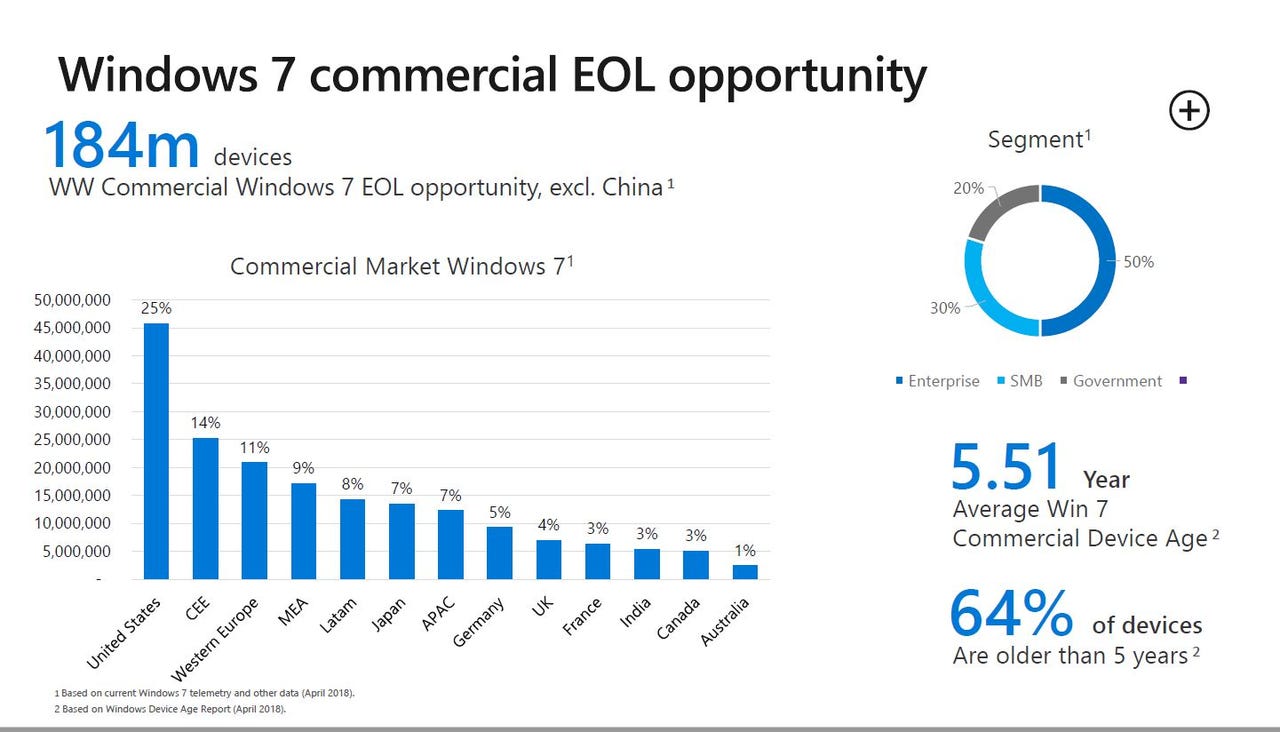Microsoft bangs the 'devices as a service' drum ahead of Windows 7's end-of-support deadline


Featured
It just might be a perfect storm.
January 14, 2020 is the last day Microsoft will provide security updates for Windows 7. According to Microsoft's estimates, there are 184 million commercial devices out there (as of April 2018 and excluding China) still on Windows 7. And 64 percent of those devices are more than five years old.
Read also: Microsoft 365: A cheat sheet - TechRepublic
For Microsoft's reseller partners, that's a huge potential opportunity, as they heard repeatedly during Microsoft's Inspire partner show last week. Traditionally, end of Microsoft support for an operating system means more chances for partners to sell customers on migration, provisioning and other services.
At the same time, the way business customers are purchasing PCs is changing. By 2020 -- the same time Windows 7 hits end of support -- 30 percent of all PCs will be acquired via DaaS, or device-as-a-service, plans, Microsoft officials told partners last week.
DaaS is the term for leasing a PC on a subscription basis, which often is coupled with other support services. It's sometimes used interchangeably with "desktop as a service." Microsoft is working on its own DaaS strategy, which for now is branded as "Microsoft Managed Desktop." (I don't know if Microsoft plans to allow partners to resell its Managed Desktop service or if the company intends to sell this service directly to business customers.)
During the Inspire show, Microsoft execs worked to hammer home the idea that resellers shouldn't simply be selling Windows 7 users a new device running Windows 10. Instead, they should take the DaaS approach and set up a whole platform to lease new Windows 10 PCs to customers.
Read also: Microsoft broke its own rules to reinvent the cardboard box - CNET
Microsoft officials told partners the sweet spot for DaaS are customers with 99 or fewer devices. A lot of these customers just don't want to manage day to day headaches around devices, said Steve Jensen, a Senior Partner Solutions Manager for Microsoft, during one session at Inspire. Partners should take advantage of this by leasing devices that are preloaded with cloud services, desktop services, security services and more, he said.
Microsoft showed partners a slide (embedded above) that outlined the DaaS framework approach. The three main components are a "modern" commercial device, meaning a device running Microsoft 365; cloud management of that device; and "modern" billing, meaning perpetually renewable leasing. These three components could be bundled together into a single, per-user monthly bill, Jensen said.
Jensen cited a study by Forrester Research done by Microsoft that showed partners could earn gross profit of more than $100 per seat per year by selling the Microsoft 365 stack via a DaaS approach.
Read also: Don't expect Microsoft's Andromeda this year... or maybe ever
Some companies already have been pushing the DaaS approach. HP, for example, offers DaaS for both Windows and Apple devices. Dell offers a number of PC-as-a-service options.
Microsoft has been pioneering the DaaS approach over the past year-plus with partners via its "Modern Desktop" pilots. The company has been encouraging partners to go beyond simple OS management and add new capabilities like device management down to the driver level as a way of distinguishing themselves.